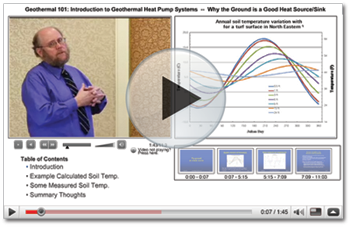Geothermal energy is a pretty interesting way to heat (and cool) structures, and make energy. One of the methods that is used to accomplish this is by use of a heat pump.
So just how do these things work? Check out this very cool video to explain it all to you.
If you don’t want to watch the video I will try and explain this as simply as I can.
Many liquids (water being one of them) boil (that is become a gas) at lower temps when the pressure of the atmosphere around them is lower. This means that water at sea level boils at 212 F, but will boil in Denver 10,000 feet up (lower atmospheric pressure) at a lower temp. You might have seen instructions on pasta for high altitude cooking instructing you to cook it for longer, this is because the boiling water in Denver is not has hot as the Boiling water in Boston.
You can use this fact along with a compressor (to play around with the pressure of the atmosphere) to “move” heat. Many people think that an air conditioner creates cold air, and then pumps it into your home. What it is actually doing is taking the heat from your home and pumping it outside. This leaves the air in your home, with less heat energy, and thus colder.
Imagine if you took an air conditioner and turned it around so that you were taking heat from outside and pumping it into your home. This is a heat pump. The air conditioner collects heat from the air outside, a geothermal heat pump might use water stored in tubes underground (where the temp is always about 50 F).
The really nice thing about geothermal heat pumps is that, while expensive to install, they are very efficient. Many will pay for themselves in 3-5 years, especially if your local government has incentive programs. The electricity needed to run them can be created with wind or solar, and because the ground is always about the same temp, you can also run them backwards as air conditioners (although they are not as efficient this way). Further more because the molten core of the earth is always replenishing the heat in the ground, this source of energy is basically infinite, and thus renewable and sustainable.

Works in Fairbanks Alaska where the temp drops to -55F
That is a great article. Thank you for sharing.